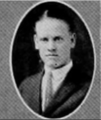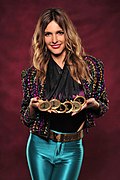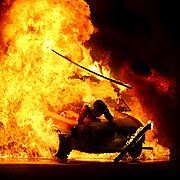Portal:Television
The Television Portal

Television (TV) is a telecommunication medium for transmitting moving images and sound. Additionally, the term can refer to a physical television set rather than the medium of transmission. Television is a mass medium for advertising, entertainment, news, and sports. The medium is capable of more than "radio broadcasting," which refers to an audio signal sent to radio receivers.
Television became available in crude experimental forms in the 1920s, but only after several years of further development was the new technology marketed to consumers. After World War II, an improved form of black-and-white television broadcasting became popular in the United Kingdom and the United States, and television sets became commonplace in homes, businesses, and institutions. During the 1950s, television was the primary medium for influencing public opinion. In the mid-1960s, color broadcasting was introduced in the U.S. and most other developed countries.
In 2013, 79% of the world's households owned a television set. The replacement of earlier cathode-ray tube (CRT) screen displays with compact, energy-efficient, flat-panel alternative technologies such as LCDs (both fluorescent-backlit and LED), OLED displays, and plasma displays was a hardware revolution that began with computer monitors in the late 1990s. Most television sets sold in the 2000s were still CRT, it was only in early 2010s that flat-screen TVs decisively overtook CRT. Major manufacturers announced the discontinuation of CRT, Digital Light Processing (DLP), plasma, and even fluorescent-backlit LCDs by the mid-2010s. LEDs are being gradually replaced by OLEDs. Also, major manufacturers have started increasingly producing smart TVs in the mid-2010s. Smart TVs with integrated Internet and Web 2.0 functions became the dominant form of television by the late 2010s.[better source needed] (Full article...)
Selected article -
In 1969, the children's television show Sesame Street premiered on the National Educational Television network (later succeeded by PBS) in the United States. Unlike earlier children's programming, the show's producers used research and over 1,000 studies and experiments to create the show and test its impact on its young viewers' learning. By the end of the program's first season, Children's Television Workshop (CTW), the organization founded to oversee Sesame Street production, had developed what came to be called "the CTW model": a system of planning, production, and evaluation that combined the expertise of researchers and early childhood educators with that of the program's writers, producers, and directors.
CTW conducted research in two ways: in-house formative research that informed and improved production, and independent summative evaluations conducted by the Educational Testing Service (ETS) during the show's first two seasons to measure the program's educational effectiveness. CTW researchers invented tools to measure young viewers' attention to the program. Based on these findings, the researchers compiled a body of data and the producers changed the show accordingly.
Selected image -

Cable News Network, commonly referred to by its initialism CNN, is a major news cable television network founded in 1980 by Ted Turner. The network is now owned by Time Warner; the news network is a division of the Turner Broadcasting System. CNN introduced the idea of 24-hour television news coverage, celebrating its 25th anniversary on June 1, 2005.
Did you know (auto-generated) -

- ... that the angel's wings in the live-action television-drama adaptation of One Room Angel took about a month to construct?
- ... that the 1999 television film Down Will Come Baby aired two weeks after the Columbine High School massacre and was criticized for exploiting parental fears with its depiction of child violence?
- ... that the television series The Owl's Legacy was modelled after the ancient Greek symposium?
- ... that a television station spent so little on programming that a media columnist called it the "IOUs of Cincinnati"?
- ... that actor Tatsunari Kimura ate pancakes and drank coffee while talking for eight hours during the filming of the television drama Old-Fashioned Cupcake?
- ... that in 1982, a news anchor for Phoenix television station KOOL-TV was held hostage on set for five hours?
Selected quote -
More did you know
- ...that the title of Dan Castellaneta's album of comedy sketches I Am Not Homer is a parody of Leonard Nimoy's first autobiography I Am Not Spock?
- ...that the 1994 Guinness television advertisement Anticipation used jump cutting techniques to make an actor appear to be performing a physically impossible dance?
- ...that actress, writer and producer Michelle Paradise created the television series Exes and Ohs without an agent?
- ...that Melbourne rock band The Strangers appeared on weekly television for nine years straight?
- ...that Ralph "Petey" Greene overcame a drug addiction and prison sentence to become an Emmy Award-winning radio and television talk show host and a guest at the White House?
Selected biography -
Rudolph Cartier (born Rudolph Kacser, renamed himself in Germany to Rudolph Katscher; 17 April 1904 – 7 June 1994) was an Austrian television director, filmmaker, screenwriter and producer who worked predominantly in British television, exclusively for the BBC. He is best known for his 1950s collaborations with screenwriter Nigel Kneale, most notably the Quatermass serials and their 1954 adaptation of George Orwell's dystopian novel Nineteen Eighty-Four.
After studying architecture and then drama, Cartier began his career as a screenwriter and then film director in Berlin, working for UFA Studios. After a brief spell in the United States he moved to the United Kingdom in 1935. Initially failing to gain a foothold in the British film industry, he did some scripting work for BBC Television in 1939 before the service was suspended at the outbreak of the Second World War. After the war, he occasionally worked for British films before he was again hired by the BBC in 1952. He soon became one of the public service broadcaster's leading directors and went on to produce and direct over 120 productions in the next 24 years, ending his television career with the play Loyalties in 1976. (Full article...)
General images
News
- December 28: US professional wrestler Jon Huber dies aged 41
- September 2: Tributes paid to recently deceased US actor Chadwick Boseman
- May 24: Japanese professional wrestler and Netflix star Hana Kimura dies aged 22
- January 16: BBC newsreader Alagiah to undergo treatment for bowel cancer
- Upcoming events
Featured content
Main topics
History of television: Early television stations • Geographical usage of television • Golden Age of Television • List of experimental television stations • List of years in television • Mechanical television • Social aspects of television • Television systems before 1940 • Timeline of the introduction of television in countries • Timeline of the introduction of color television in countries
Inventors and pioneers: John Logie Baird • Alan Blumlein • Walter Bruch • Alan Archibald Campbell-Swinton • Allen B. DuMont • Philo Taylor Farnsworth • Charles Francis Jenkins • Boris Grabovsky • Paul Gottlieb Nipkow • Constantin Perskyi • Boris Rosing • David Sarnoff • Kálmán Tihanyi • Vladimir Zworykin
Technology: Comparison of display technology • Digital television • Liquid crystal display television • Large-screen television technology • Technology of television
Terms: Broadcast television systems • Composite monitor • HDTV • Liquid crystal display television • PAL • Picture-in-picture • Pay-per-view • Plasma display • NICAM • NTSC • SECAM
Categories
WikiProjects

|
You are invited to participate in WikiProject Television, a WikiProject dedicated to developing and improving articles about Television. |
- Main projects
- Sub-projects
Television Stations • American animation • American television • Australian television • British TV • BBC • Canadian TV shows • Television Game Shows • ITC Entertainment Productions • Digimon • Buffyverse • Doctor Who • Degrassi • EastEnders • Episode coverage • Firefly • Futurama • Grey's Anatomy • Indian television • Lost • Nickelodeon • The O.C. • Professional Wrestling • Reality TV • The Simpsons • Seinfeld • South Park • Stargate • Star Trek • Star Wars • Soap operas • Avatar: The Last Airbender • House
- Related projects
Animation • Anime and manga • Comedy • Comics • Fictional characters • Film • Media franchises
What are WikiProjects?
Things you can do

- Place the {{WikiProject Television}} project banner on the talk pages of all articles within the scope of the project.
- Write: Possible Possum
- Cleanup: color television, Alien Nation: Body and Soul, The Sopranos, Alien Nation: Dark Horizon, Alien Nation: The Enemy Within, Alien Nation: Millennium, Aang
- Expand: Timeline of the introduction of color television in countries
- Stubs: Flow (television), Just for Kicks (TV series), Play of the Month, Nova (Dutch TV series), More stubs...
Subportals
Related portals
Associated Wikimedia
The following Wikimedia Foundation sister projects provide more on this subject:
 Commons
Commons
Free media repository Wikibooks
Wikibooks
Free textbooks and manuals Wikidata
Wikidata
Free knowledge base Wikinews
Wikinews
Free-content news Wikiquote
Wikiquote
Collection of quotations Wikisource
Wikisource
Free-content library Wikiversity
Wikiversity
Free learning tools Wiktionary
Wiktionary
Dictionary and thesaurus


























































